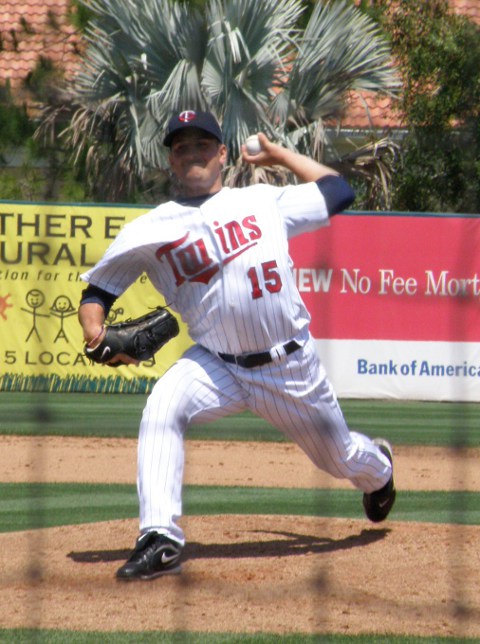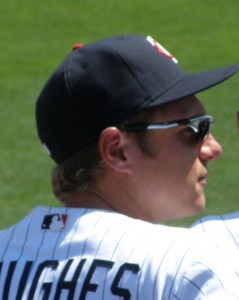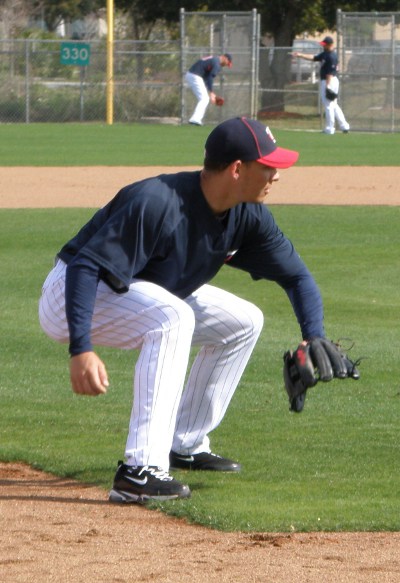By this point, everyone knows the variables that will determine whether the Twins will have a successful 2012 season, right? Mauer, Morneau, Baker and Span have to stay healthy and the bullpen needs to be vastly improved over last year. We know all of that because every beat writer, columnist and blogger has pointed at those issues over and over again since October.
Sure, if the established veterans all return to the level of productivity we’ve come to expect from them, the Twins should avoid the kind of meltdown they suffered through last season. That said, if the team is going to actually contend in 2012, they’re going to need more. They will need breakout seasons from players that have not yet demonstrated that they belong among the American League’s elite names at their positions.
But where can the Twins expect to find those potential breakout seasons?
The typical arc of a professional baseball player’s career is actually more predictable than one might think. Their prime years are pretty much from ages 26 to 32. We all spent a lot of time discussing the back end of that range during the offseason, as we discussed the pros and cons of offering multi-year contracts to Michael Cuddyer, who is just past that “prime” range, and Joe Nathan, who is well past it.
But when you are looking for potential breakout years, it makes more sense to focus on the front end of the range. The Twins are notorious for bringing their minor league prospects along slowly through the organization and, for a club with a reputation for disregarding advanced statistical analysis, it appears that they may have a basis for this particular proclivity. Projecting that most players hit their strides at age 26, I doubt that it’s a coincidence that most Twins prospects aren’t often starting their Major League careers (and their arbitration clocks) until they’re at least 24 years old. The Twins apparently try to time a player’s Big League debut a year or two before they expect him to break out and become a fully productive Major League ballplayer, then get as much of their peak years as possible while they’re still affordable.

For example, Cuddyer was getting his first real full-time duty with the Twins at age 25 and had his first OPS above .800 (or first OPS+ season over 100, if you prefer that metric) in his age 27 season. Torii Hunter got a taste of the Big Leagues in the season during which he turned 24, but he really figured it out in 2001, the season he turned 26. More recently, Glen Perkins may have made his debut at age 24, but it wasn’t until last year, in his age 28 season, that he carved out a meaningful role for himself with the Twins.
Armed with this knowledge, who should we be looking at in 2012 as having the potential to have breakout seasons? Here’s a list of possible candidates:
Trevor Plouffe turns 26 years old in June. He’s shown some pop in his bat and, let’s be honest, if he had demonstrated passable defensive abilities, he’d be the Twins regular shortstop right now. If he can play a decent outfield, Plouffe could establish himself this season. But few players really get it all figured out in their first full year of regular time in the Show, so we should probably hold off on establishing those expectations of Trevor quite yet. Maybe next year.
The same would be true of pitchers Anthony Swarzak and Kyle Waldrop. Both will be 26 years old pretty much throughout the upcoming season, but given their relative lack of Major League experience, it’s probably not realistic to expect them to have Glen Perkins-like results already this season.

Infielder Luke Hughes is starting his age 27 season and he got a few swings in at the Big League level last year, so we can hope to see him step his game up a little bit. He’s not currently penciled in for a regular starting job, though, so you have to wonder if he’ll get the plate appearances necessary to make significant strides in 2012.
So if those candidates aren’t likely to break out, who will?
First, keep in mind that Denard Span just turned 28 years old a couple of weeks ago, so while he’s arguably already had his breakout season, he’s still on the front side of his peak years. He’s reached the point of being physically mature and has enough experience that he really should no longer be seeing much of anything offensively or defensively for the first time. That being the case, I’d like to see Span take a big step forward with his game this season, assuming he can stay healthy.
Another familiar name on my list of potential breakout seasons is Francisco Liriano. We’ve been waiting for him to have a true breakout season for what seems like forever. Despite having several seasons of Major League experience in the books, Liriano is still just now entering his age 28 season. That’s slightly past our “breakout season” ages, but it’s not too late to see it happen… yet. That said, this is arguably the last year that anyone can make the, “he’s still a young pitcher with potential,” statement, so it’s now or never (at least with the Twins organization) for Frankie.
If it seems like Alexi Casilla has been around forever, too, it’s because he has. He was rushed a bit after being acquired from the Angels for J.C. Romero and his service clock started while he was still just 23 years old. That means he’s just now entering his age 27 season (he turns 28 in July). Casilla has been inconsistent, to say the least. But this season, he’s starting off at what’s arguably his best defensive position, second base, and so far this spring he’s making good contact from his spot at the bottom of the Twins order. The game should finally be slowing down a bit for Lexi and if he can play decent defense while getting on base with regularity, he could play a significant positive role for the Twins in 2012.

Finally, the guy with perhaps the greatest potential for having a true breakout season is third baseman Danny Valencia, who will be 27 years old throughout the first five months of the season. Valencia’s had two full years now to adjust to Big League pitching and there’s no reason he shouldn’t take a major step forward in 2012. Everyone seems to project Valencia as hitting in the #7 spot in the Twins lineup and he very well may start the season there, but if he’s still hitting in the bottom third of the order in August, I’ll be disappointed.
So those are my “breakout season” picks… Liriano, Casilla and Valencia (with some additional improvement also from Span). Talk all you want about Mauer, Morneau, Baker and the bullpen, but in my mind, the Twins’ success, or lack thereof, this season is riding just as much on the ability of these players to make significant strides as any other factor. They are hitting their prime years and it’s time for them to show fans what they’re made of.
– JC

“The Twins are notorious for bringing their minor league prospects along slowly”
This is an urban legend among Twins fans. If you look at the Twins players, very few of them started their major league careers at age 26 and older. Last year’s players 27 and younger:
27 – Span, Liriano, Slowey, Capps
26 – Valencia, Casilla, Nishioka, Hughes, Mijares
25 – Plouffe, Young
24 – Tosoni
23 – Revere, Burnett
Where are the “prospects brought along slowly”? You could make a case for Perkins, but he was in the starting rotation at 25, as was Baker. Blackburn was there at 26. Duensing, and maybe Hughes, is really the only guy on the team you can
argue was not given a major league spot before age 26.
Guys like Duensing, Blackburn, Liriano and Valencia certainly can improve a lot on last year. But they are past the point of having “breakouts”. They are more like Glen Perkins, guys who might again have a season that reflects their talent.
Ben Revere and Trevor Plouffe are really the only guys who are at all likely to have breakout seasons. And they aren’t going to put together big years that would rival the improvements needed over last year from Mauer, Morneau, Baker and Span.
As per usual, TT, we’ll have to just agree to disagree.
We obviously have different definitions of “breakout season.” As I mentioned in the post, I’m looking for guys who step up their games to a level where they can be considered among the best at their position in the AL. Revere and Plouffe almost certainly won’t be doing that.
The players I mentioned are hitting their prime productivity years and while I have varying degrees of confidence (or lack thereof) in their ability to take that next step, they all have enough time in the Big Leagues that they could step up and make people notice them… and I believe it’s important to the Twins that at least a couple of them do exactly that.
I also never suggested the Twins don’t bring players up until they’re 26 years old. I indicated that the Twins don’t often see players debut until they’re at least 24 years old. I suppose not everyone would consider that being later than other teams, but the point is that it’s a relatively rare exception that you see a Twins player starting his service clock at 21-22 years old. Even 23 is more the exception than the rule.
“the point is that it’s a relatively rare exception that you see a Twins player starting his service clock at 21-22 years old. Even 23 is more the exception than the rule.”
You can count the guys who are playing regularly in the big leagues at 21 on one hand. In fact, there were only 8 major league players who were 23 or younger and played in more than 100 games last year, including Ben Revere. There were 12 pitchers 23 and under who got more than 100 IP.
Its not that the Twins are slow to promote players. Its that players are rarely ready to play in the big leagues at that age. And if they are, there still needs to be an opening for them.
“step up their games to a level where they can be considered among the best at their position in the AL.”
None of the guys you listed are likely going to do that. Plouffe and Revere do have the upside to get there. Its not likely this year. But neither is it likely Valencia is going to become one of the better third basemen in the league. Or that Liriano is going to become an elite pitcher and start pitching deep into games. Or that Span is suddenly going to add home run power or improve his range to match Revere’s. Casilla is the only one of those guys who might have that kind of upside, if he can just stay healthy for a year.
Obviously, I don’t share your opinions, TT, but thank you again for sharing them.
Thanks Jim. I’m on board. I’m not really a numbers cruncher, but I want to say that Torii figured it out at the plate around age 26.